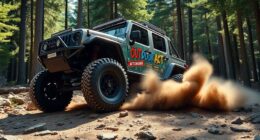To calibrate your GM 10L90E transmission for drag racing, start by adjusting the shift points to keep the engine in its peak power band, using a tuner or ECU software. Fine-tune the torque converter’s stall speed to improve launches without causing excess heat or slipping. Continuously monitor data like RPM and slip, making small adjustments to optimize shifts and maximize performance. Keep learning as you fine-tune for the best results.
Key Takeaways
- Adjust shift points in the ECU or transmission controller to keep engine within peak power RPM during launches.
- Fine-tune converter stall speed to optimize launch torque and minimize bogging off the line.
- Use data logging tools to monitor slip, RPM, and shift timing, making incremental adjustments for optimal performance.
- Set proper shift RPMs just above peak torque to ensure efficient, crisp gear changes without over-revving.
- Continuously monitor transmission data to balance performance gains with component durability during high-stress drag runs.

Calibrating GM’s 10L90E transmission is a crucial step to guarantee peak performance and longevity. When you’re preparing your vehicle for drag racing, fine-tuning the transmission ensures that every shift is crisp and efficient, giving you the best possible acceleration and consistency. A key part of this calibration involves adjusting the torque converter and shift points to match your racing demands. The torque converter’s stall speed, in particular, needs to be refined so that it provides maximum torque multiplication without causing unnecessary strain or slipping during high-stress launches. By selecting an appropriate stall speed, you can reduce bogging off the line and improve your 60-foot times, making your runs smoother and more powerful.
Next, focus on setting your shift points. These are the RPM levels at which your transmission shifts gears during acceleration. Properly calibrated shift points ensure the engine stays within its power band, avoiding shifts that are too early or too late. If the shifts occur too early, you risk losing valuable acceleration, while shifting too late can cause the engine to over-rev, potentially damaging components. To find the suitable shift points, you’ll need to access the transmission’s tuning parameters, often through a high-quality ECU or transmission controller. Many racers prefer to set shift points just above the peak torque RPM to maximize power transfer and maintain momentum through the traps.
When adjusting these parameters, pay close attention to the data logs from your runs. Use a scan tool or tuner to monitor real-time engine RPM, transmission slip, and shift timing. Make incremental adjustments—small changes can markedly impact performance. For example, increasing the torque converter’s stall speed slightly can improve launch performance, but go too high, and you might experience excessive heat or slipping. Similarly, fine-tune your shift points so shifts happen at the ideal RPM, ensuring the engine remains in its power zone without over-revving. Additionally, understanding the contrast ratio of your transmission and related components can help you optimize for better performance and durability during high-stress runs.
Frequently Asked Questions
Can I Calibrate the 10L90E Myself Without Professional Tools?
You can attempt DIY calibration of your 10L90E transmission, but it’s challenging without proper calibration tools. While some basic adjustments might be possible through the vehicle’s tuning software, precision tuning for drag racing requires specialized equipment and expertise. Without these calibration tools, you risk incorrect settings that could damage your transmission or reduce performance. For the best results, consider consulting a professional or investing in the right calibration tools.
How Often Should I Recalibrate the Transmission for Optimal Performance?
They say “prevention is better than cure,” and that applies here. You should recalibrate your 10L90E transmission regularly, roughly every 10,000 to 15,000 miles or if you notice shifting issues. Proper calibration guarantees transmission longevity and peak performance. Keep an eye on your vehicle’s behavior and don’t wait too long—sticking to recommended calibration intervals helps you avoid costly repairs and keeps your drag racing setup running smoothly.
What Are Common Signs Indicating Calibration Issues With the 10L90E?
You’ll notice calibration issues with your 10L90E if you experience sensor malfunctions or shifting delays. Sensor malfunctions often cause erratic shifts or sudden transmission behavior, while shifting delays make your gear changes sluggish or unpredictable. These signs indicate your transmission isn’t adjusted correctly. Addressing these issues promptly ensures smoother performance and prevents further damage, especially if you’re pushing your vehicle for drag racing.
Does Calibration Affect Fuel Economy and Engine Longevity?
Calibration directly impacts your vehicle’s fuel efficiency and engine wear. When you optimize the transmission settings, you guarantee smoother shifts and better power delivery, which conserves fuel and reduces strain on the engine. Conversely, poor calibration can cause unnecessary engine wear and lower fuel economy, leading to costly repairs and reduced performance. Proper calibration helps you maximize both fuel efficiency and engine longevity, keeping your vehicle running reliably longer.
Are There Specific Software Updates Needed for Calibration Compatibility?
Did you know that 85% of transmission issues stem from outdated software? When it comes to calibration compatibility, you need to verify your software updates are current. This guarantees your transmission functions properly and maintains ideal performance. Regular updates improve calibration accuracy, helping you avoid glitches and achieve the best drag racing results. Always check for the latest software updates before calibrating your GM 10L90E transmission to guarantee compatibility and peak performance.
Conclusion
Now that you know how to calibrate GM’s 10L90E transmission for drag racing, you’re well on your way to revealing its full potential. Remember, fine-tuning takes patience, but don’t let that discourage you—sometimes you’ve got to bite the bullet to get it just right. Keep testing, adjusting, and pushing your limits. With a little perseverance, you’ll be hitting those quarter-mile times like a pro in no time.










